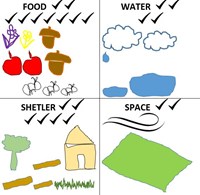- Lesson Plan (172)
- Field Trips (40)
- Distance Learning (34)
- Student Activities (23)
- Other Education Materials (8)
- Traveling Trunk (8)
- Guest Speakers (4)
- Teacher Reference Materials (4)
- Science Labs (2)
- Science (243)
- Social Studies (71)
- Literacy and Language Arts (56)
- Math (38)
Showing 286 results for wildlife habitat ...
Upper Piedmont Wildlife Habitat Prior to 1781
- Type: Student Activities
- Grade Levels: Upper Elementary: Third Grade through Fifth Grade
To have students define what kind of habitat an animal would have needed to survive in the upper Piedmont of the Carolinas prior to the Battle of Cowpens. Students will describe elements that contributed to the animal’s extinction from the area
Habitat
- Type: Distance Learning
- Grade Levels: Lower Elementary: Pre-Kindergarten through Second Grade
Habitats
- Type: Lesson Plan
- Grade Levels: Lower Elementary: Pre-Kindergarten through Second Grade
•Describe the 5 major biomes on Earth •Describe the factors that make up a successful habitat
Wildlife Safari
Habitat Adventure
- Type: Distance Learning
- Grade Levels: Lower Elementary: Pre-Kindergarten through Second Grade

A ranger will take your class on a virtual "hike" to discover the four different habitats of Glacier National Park. We will learn what living things need to survive and meet at least one animal that lives in each habitat. Come prepared for an adventure, as you never know what will happen in the wild!
Habitat Investigators
- Type: Distance Learning
- Grade Levels: Lower Elementary: Pre-Kindergarten through Second Grade
Habitat Is Home
Habitat Hunt
A Habitat Is A Home
Basics of Habitat
What's That Habitat
Wildlife of the Tropical Rainforests
- Type: Lesson Plan
- Grade Levels: Middle School: Sixth Grade through Eighth Grade

This program motivates kids to think about the part each of them plays or the actions they can take in preserving and protecting the environment. Activity is focus on tropical rainforest and wildlife as the basis for teaching science through fun, hands-on things children already do and like like-art projects, and classroom demonstrations. Discover the amazing diversity of wildlife and habitats from the coastline to mountaintop.
Winter Wildlife Traveling Trunk
Marine Wildlife and Harmful Trash
- Type: Lesson Plan
- Grade Levels: Middle School: Sixth Grade through Eighth Grade

Students listen to descriptions of marine wildlife and identify marine debris items that could harm them. Students perform an experiment in which they wrap a rubber band around their fingers and across the back of their hand and try to disentangle them. As a class, students discuss their thoughts and reactions and relate to real animals.
Creepy Crawly Habitat
Habitat Scavenger Hunt
- Type: Student Activities ... Other Education Materials
- Grade Levels: Lower Elementary: Pre-Kindergarten through Second Grade

Walk around a safe outside space with adult supervision and make a mark every time you see an example of food, water, shelter, and space. These are what animals need in their habitats to survive. You can write in a little dot, a checkmark, or you can even draw a little picture. Hint: A shelter could be a nest or a house, but remember it could also be the area underneath a log! Try with a partner and compare what you find!
Prairie Animals and Habitats
- Type: Distance Learning
- Grade Levels: Lower Elementary: Pre-Kindergarten through Second Grade

Badlands National Park protects 244,000 acres of mixed-grass prairie habitat and the wild animals that live in it. Prairie vegetation is mostly grasses--find out why. Then take a look at some of the wildlife (including bison, pronghorn, prairie dogs, and black-footed ferrets) that have adaptations that allow them to thrive in the prairie environment. Students participating in the in-class program may see and touch animal pelts, complete a puzzle, or complete a craft.
Surviving in the Wild
- Type: Lesson Plan
- Grade Levels: Lower Elementary: Pre-Kindergarten through Second Grade

Students role play a day in the life of a pet animal and then sort pictures of a variety of animals into “wild” or “domestic” categories with the option of making collages of each category. They will think about how “wild” animals are different from domestic animals and why wild animals need “wild” places to live.












